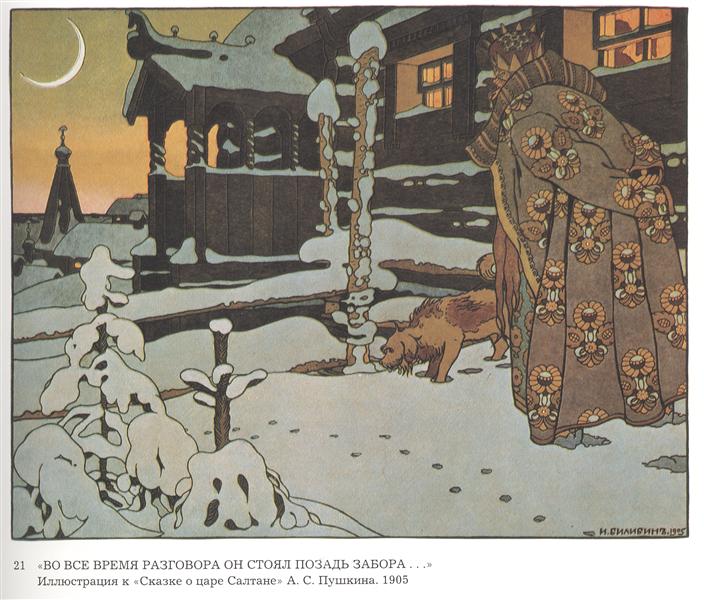Description
The work "Illustration for the 'Fairy tale of Saltan' by Alexander Pushkin - 1905" by Ivan Bilibin is a piece that encapsulates the rich tradition of Russian folklore and Pushkin's poetic narrative. Bilibin, an outstanding Russian illustrator, is known for his distinctive style that mixes elements of traditional Russian iconography, Art Nouveau and modernist stylization. This illustration, in particular, is part of a broader project: the series of illustrations for the literary adaptation of the Pushkin fairy tale, which was published in 1905.
Analyzing the composition of the painting, we observe a coastal landscape where a central figure faces a vivid and dynamic maritime environment. The image intricately combines natural beauty with fantasy, characteristic of both Bilibin's style and the original Pushkin text. The central figure, a princess discernible by his traditionally ornate attire, adopts an introspection position while the natural elements around him, especially the agitated sea and aquatic creatures, manifest energy and movement. The main figure seems to be on a rock that emerges from water, perhaps symbolizing a connection between human spirituality and indomitable nature.
Color is one of the most shocking aspects of this work. Bilibin uses a vibrant palette where the blue tones of the sea predominate, contrasted with the richly colored clothing of the protagonist. The details of the female figure dress, with its complex patterns and intense colors, reflect Russian textile crafts, which Bilibin portrays with meticulous care.
Likewise, the Enlightenment incorporates decorative elements in the upper right corner, such as geometric and floral patterns, which frame the main action and add a layer of ornamentation characteristic of bilibin work. These details not only enrich visual composition, but also allude to the aesthetics of illuminated manuscripts and Russian popular crafts.
The maritime environment, plagued with swirls and marine creatures, is represented with a fantasy that is both detailed and stylized. Bilibin manages to capture the essence of the fairy tale, transfiguring nature into an almost theatrical scenario, where each element is imbued with a magical symbolism. This approach reflects the close relationship between folklore and Russian cultural identity, which Bilibin valued and celebrated throughout his career.
Ivan Bilibin, beyond being a mere illustrator, was a visual chronicler of mythology and folklore. His work in this series not only illustrates Pushkin's narrative, but contextualizes it within a broader artistic vision that celebrated the traditions, myths and legends of Russia. Through works such as this, Bilibin not only tells a fairy tale, but also creates a bridge between literature and visual arts, demonstrating his mastery to turn words into images that pustle life and color.
In conclusion, the "illustration for the fairy tale of the zar jumps'" is a work of art that encapsulates Ivan Bilibin's ability to transform poetic prose into a dazzling visual composition. The richness of its colors, the intricate attention to detail and the ability to evoke a magical atmosphere are testimony of their talent and its deep love for Russian culture.
KUADROS ©, a famous paint on your wall.
Hand-made oil painting reproductions, with the quality of professional artists and the distinctive seal of KUADROS ©.
Art reproduction service with satisfaction guarantee. If you are not completely satisfied with the replica of your painting, we refund your money 100%.

